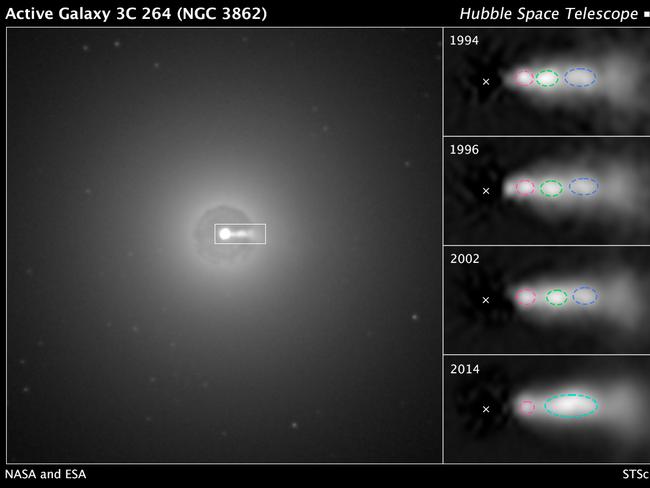Hubble telescope sees black hole’s plasma ‘beam’ colliding with matter
THIS death star is fully armed and operational: The Hubble telescope has just spotted its planet-killing beam in action. Is it really moving much faster than the speed of light?
THIS death star is fully armed and operational: The Hubble telescope has just spotted its planet-killing beam in action. Is it really moving much faster than the speed of light?
In a galaxy far far away — 260 million light years away, to be exact — a titanic event of interstellar proportions is taking place (well, it happened 260 million years ago — but we’re just getting to see it).

A supermassive black hole has been spotted “firing” jets of super-energised plasma at velocities which, at first glance, appear to be moving at an incredible seven times the speed of light.
One such blast has hit something — and the enormous flare of its vaporisation has been discovered in a timelapse sequence of images taken by Hubble over the course of two decades.
Titanic clash
An article in the science journal Nature reports Hubble first detected the stream of plasma in 1992, in the galaxy NGC 3862. A string of images — the most recent being from 2014 — have now been stitched together to reveal the activities of the enormous energy involved.
“The colossal energies in this jet are hard to imagine and yet they are so large that it takes years to see them change, having a movie like recording is amazing and to see a collision within the jet is unheard of,” says Swinburne University astrophysicist Dr Alan Duffy

It’s probably not Alderaan. Star Wars aside, scientists believe the plasma jet may have rear-ended an earlier burst of matter ejected from the same black hole.
You can see them in the animation — a stream of blobs advancing outwards.
This is not the speed you are looking for...
Eileen Meyer of the Space Telescope Science Institute (STScI) in Baltimore, Maryland, noticed one fast knot of plasma shoot out at an apparent speed of seven times the speed of light — and slam into a slower moving ejection in front of it.
But the super-energised plasma had not broken Einstein’s universal speed limit: It was an optical illusion caused by the speed it is actually moving — an incredible 98 per cent of the speed of light.
DEATH IN STAR BIRTH: New light cast on ‘Pillars of Creation’
WANDERERS: 14 ‘Death Stars’ headed our way
“The speed is just an optical illusion as the jet is actually pointing in our direction - meaning that the blobs at the end of the jet are much closer to us than the blobs at the start,” Dr Duffy says. “If they’re closer to us then light from them will take less time to reach us. Given the enormous distances and speeds involved, this means they appear to travel that distance across the sky in less time, so we think they’re traveling faster.”

Insane amounts of energy
The collision is taking place thousands of light years outside the galaxy the jets originated from.
“Something like this has never been seen,” Meyer said.
The clump of plasma in the process of being destroyed may have been travelling slower due to the “drag” of interstellar gas. The plasma which came up from behind likely had a faster trip in the first one’s “slip-stream”.
MIND BENDING: Are we living on the edge of a 4D black hole?
“Each of the blobs colliding have basically the mass of Jupiter... travelling at close to the speed of light,” Dr Duffy says. “This is just an insane amount of energy. We build a track 27km long in the Large Hadron Collider just to accelerate a few atoms to that sort of speed, and nature is doing it to something the mass of a Gas Giant. Ridiculous.”
A galaxy’s engine room
Exactly how such streams of energy are formed and ejected by the supermassive black holes at the core of most galaxies is poorly understood.
But it is thought magnetic fields around the black hole at the core of the galaxy can concentrate highly energised matter accumulating around the event horizon and “spin it off” in concentrated beams.

As matter does not fall into the black hole evenly, it can appear to be ejected in a series of “burps”.
While such jets have been detected by X-ray and radio scans of distant galaxies, very few have been seen in optical wavelengths.




